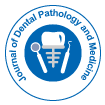Necrotizing Periodontal Diseases: A Comprehensive Overview
Received Date: Feb 01, 2025 / Accepted Date: Feb 28, 2025 / Published Date: Feb 28, 2025
Abstract
Necrotizing periodontal diseases (NPDs) are a group of acute inflammatory conditions affecting the periodontium, characterized by rapid onset, severe pain, and extensive soft tissue destruction. They represent some of the most severe forms of periodontal disease and are classified into necrotizing gingivitis (NG), necrotizing periodontitis (NP), and necrotizing stomatitis (NS), reflecting a continuum of disease severity. Although uncommon in developed populations, NPDs are more prevalent in immunocompromised individuals, malnourished populations, and in regions with limited access to oral healthcare. A comprehensive overview of the etiology, pathogenesis, clinical features, diagnosis, and management of NPDs. The etiology is multifactorial, involving a complex interplay between microbial infection primarily involving anaerobic bacteria such as Fusobacterium nucleatum, Prevotella intermedia, and spirochetes like Treponema species and host immune response. Predisposing factors include HIV infection, stress, smoking, malnutrition, poor oral hygiene, and systemic conditions that compromise host immunity. Clinically, NPDs are distinguished by the presence of "punched-out" interdental papillae, spontaneous bleeding, severe halitosis, and rapid tissue necrosis. In advanced cases, bone exposure and sequestration may occur, particularly in necrotizing stomatitis. Diagnosis is primarily clinical, supplemented by microbial analysis and, in some cases, histopathology to rule out malignancies or other systemic conditions. Effective management involves acute-phase therapy with mechanical debridement, systemic antibiotics, and antimicrobial rinses, followed by long-term maintenance care and correction of underlying risk factors. In immunocompromised patients, a multidisciplinary approach involving medical consultation is essential. Despite appropriate treatment, recurrence is common, especially in individuals with persistent risk factors. Given the potential for rapid progression and systemic implications, early recognition and intervention are crucial. This review aims to consolidate current knowledge on NPDs, highlighting clinical diagnostic criteria, therapeutic strategies, and areas requiring further research, particularly in the context of emerging immunosuppressive conditions and global health disparities.
Citation: Emily C (2025) Necrotizing Periodontal Diseases: A ComprehensiveOverview. J Dent Pathol Med 9: 256
Copyright: 穢 2025 Emily C. This is an open-access article distributed under theterms of the Creative Commons Attribution License, which permits unrestricteduse, distribution, and reproduction in any medium, provided the original author andsource are credited.
Select your language of interest to view the total content in your interested language
Share This Article
Recommended Journals
91勛圖 Journals
Article Usage
- Total views: 170
- [From(publication date): 0-0 - Sep 04, 2025]
- Breakdown by view type
- HTML page views: 126
- PDF downloads: 44
